Article and photos by Joseph Sapia
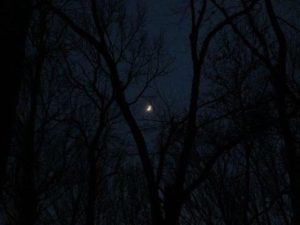
Above the Manalapan Brook floodplain, a crescent moon waxed toward December’s Full Long Nights Moon

Christmastime in Fair Haven, Monmouth County
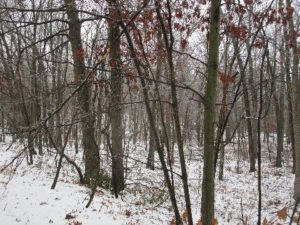
Snowfall of 1-1/2 inches December 17 in the Jamesburg Park Conservation Area, Middlesex County
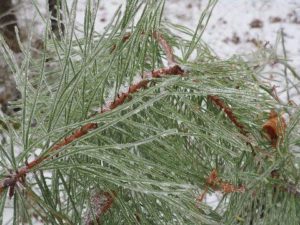
Ice builds up on the needles of a pitch pine, Pinus rigida, the common tree of the New Jersey Pine Barrens. Here, in the Jamesburg Park Conservation Area in the Pine Barrens around Helmetta.

Christmastime at historic Longstreet Farm, the Monmouth County Park System’s living history farm, replicating the late 1800s in Holmdel. Here, baking cookies the old-fashioned way.
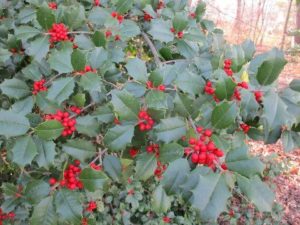
Holly in my neigbhorhood in Monroe, Middlesex County.
Joe Sapia, 60-years-old, grew up and lives in the Pine Barrens around Helmetta, where his family has resided for more than 100 years. He can be reached at Snufftin@aol.com or at P.O. Box 275, Helmetta, 08828.
Article and photos by Joseph Sapia

Shekiro’s Pond in Helmetta
Joey Slezak grew up in South Jersey, but he has multi-generational roots in the Pine Barrens around Helmetta and has lived in his parental grandparents’s former house in Helmetta while studying at Rutgers University in New Brunswick. In his own right, Joey is a meteorology student at Rutgers, an outdoorsman, and, importantly to me in the outdoors, my go-to science guy.
I was looking forward to walking afield with him – perhaps not on as cold a day as February 18, 2015. Minus 1 degree at dawn and 9 degrees when I left my house about two hours later. But between our schedules, we had to take advantage of this opportunity, cold or not. Plus, we are woodsmen from Helmetta of tough local Polish stock. So, we plunged into the approximately 15 degrees when we finally started walking before 10 a.m.
A woodpecker hammered away. A few inches of snow covered the ground – on the surface, it was fluffy — and clung to trees.
“You could see the snow fall from the trees, these little flakes go by,” said Joey, 22-years-old at the time and working on his bachelor’s degree in meteorology.
On this day, we would spend much time in wetlands, including an Atlantic white cedar swamp being threatened by invasive phragmites.
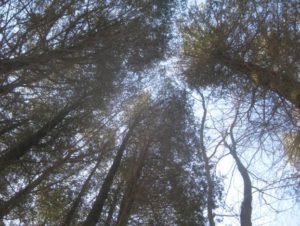
Looking skyward from the Atlantic white cedar swamp
“This is probably as secluded as you could be in these woods,” I said.
It was very quiet, until a jet airplane flew by.
“The final approach to Newark Airport comes over us,” Joey said.
Despite the cold, I was surprisingly warm.
“Once you heat up your clothes, there’s no wind to dissipate it,” Joey said. “(And) you’re dressed for it.”
I was dressed in long underwear, bottoms and tops; covered with a sweater and windbreaker jacket, all made of materials to wick sweat.
Joey pointed out hoar frost, a crystallized coating of frost. With the hoar frost, Mother Nature worked her art on any icy surface of water and on blades of vegetation.

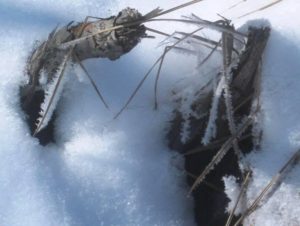
Mother Nature’s artwork: hoar frost.
Here and there, we were in danger of breaking through the swamp ice. I went up to my shins at one point, up to my thigh at another. Joey noted how he could smell the swamp when I broke through.
As we walked, we noticed evidence of the day’s low humidity – in the clarity and blueness of the sky.
“Not a cloud in the sky (hardly), a bluebird day,” said Joey, who, now in 2017, is working on his master’s degree in atmospheric science.
As we walked a sand road, we noticed fallen trees, lying northeast to southwest.
“That’s probably coastal,” Joey said, meaning a storm out of the east, rather than in the normal flow of wind from the west.
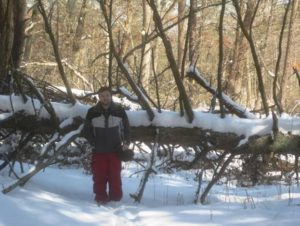
Joey Slezak at a treefall.
Perhaps the highlight of the day was hearing the call – a running-a-finger-along-the-teeth-of-a-comb sound — of a New Jersey chorus frog. This frog is an early caller, breeding as early as February, according to New Jersey Division of Fish and Wildlife literature.
“That sun’s getting warm,” Joey said.
By the time we ended the walk at lunchtime, the temperature was about 30.
“I had a lot of work to do, a lot of stress,” Joey said. “It felt pretty good to get out there.”
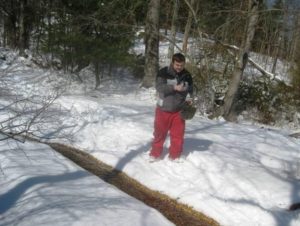
Joey Slezak at a small stream
Joe Sapia, 60-years-old, grew up and lives in the Pine Barrens around Helmetta, where his family has resided for more than 100 years. He can be reached at Snufftin@aol.com or at P.O. Box 275, Helmetta, 08828.
Article and photo by Joe Mish
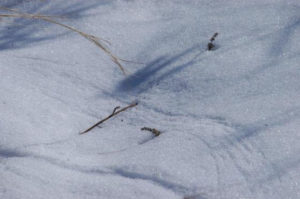
The hand of the wind uses the delicate grass to etch its thoughts in the snow. Nature’s secrets are whispered among the wooded hills and fields for all who pause to ‘listen’.
March is the month when winter puts its house in order to depart our latitude on its tour of the earth.
Remnants of left over winter wind, swept from dark, frozen nooks and crannies, are set free to blow themselves out in the twenty days leading to the arrival of spring.
The force of the wind breathes life into tree canopies and grasses as they dance and sway to the tune of the invisible but palpable energy. There is joy expressed when those, planted in place, unable to change location, experience rhythmic movement in perfect time.
A linear mass of silver maple trees, along the river’s edge, branches tipped with red velvet buds, sway in unison, as they execute a perfect ‘wave’, encouraged on by a burst of wind which leads the cheer.
Consider that the trees and tall meadow grass have evolved to take advantage of the wind. Dispersion of seed that still cling to stems and pods are sent aloft on a later flight to give the best chance for germination than seeds dispersed months earlier.
Trees benefit from the March wind as broken, insect infested branches are excised in a manner to suggest surgical intervention to remove a cancerous limb. The wind effectively prunes tree branches to allow sunlight to penetrate the canopy and promote new leaf growth; each leaf a new solar factory to boost the tree’s nutrient supply.
The wind has a wide range of expression that arises from deep internal turmoil. Perhaps the wind offended the gods in a prideful manner that justified eternal punishment. The gods therefore made the wind invisible to all the senses except for touch, and then only when the wind moves.
The wind constantly struggles with this blow to its vanity and does its best to make its presence known by channeling other elements.
Think about the wind and the scale of expression from hurricanes and tornadoes to a gentle whisper, where the wind uses a dried stem of grass or tree branch to etch its thoughts in the snow or the side of a wood building.
A spring breeze, carrying the scent of lavender blossoms, adds another dimension to the wind’s ‘visibility’ as the wind assumes the identity of the aroma. This is an expanded statement of expression; a loophole to get around the punishment imposed by the gods. This pleases the wind.
As the wind struggles to regain its physical identity and frustration builds, snow and ice are incorporated to flesh out the wind and give it a visible form.
Sometimes the desire to be seen is so fierce, the wind driven snow and ice makes the sense of sight useless, adding to the wind’s frustration, causing it to howl louder and blow harder.
The blustery wind, complement of March’s winter legacy, eventually subsides to become the gentle breeze of spring. The edge of winter passes and tempers the winds attitude to more gentle expressions of mood.
Author Joe Mish has been running wild in New Jersey since childhood when he found ways to escape his mother’s watchful eyes. He continues to trek the swamps, rivers and thickets seeking to share, with the residents and visitors, all of the state’s natural beauty hidden within full view. To read more of his writing and view more of his gorgeous photographs visit Winter Bear Rising, his wordpress blog. Joe’s series “Nature on the Raritan, Hidden in Plain View” runs monthly as part of the LRWP “Voices of the Watershed” series. Writing and photos used with permission from the author.
Article and Photos by Jess Niederer
On this rainy 2017 day, I am just fresh back in the office after a drive past a whole lot of farms. Many farms drain their surface water out to the road, and in these saturated conditions, you can usually see how well the farmers’ erosion prevention measures are working. You know when you should wince? It’s when that run-off in the ditches looks like chocolate milk. I saw a fair share of chocolate milk run-off out there today. Why should that bother us? It puts silt in the streams (smothers a healthy benthic zone ecology), it puts nutrients in the streams, it puts any present agricultural chemicals in the streams, and it takes topsoil (which takes 100 year/inch to form) off the field.
And someone, yes, a human, is gonna have to drink that water after some imperfect filtration process. Humans not your thing? Well, first the fishes will have to live in it. Scales don’t strum your heartstrings? Alright…the adorable baby foxes will have to drink it too. Not really an animal fan at all? OK, the nutrients may cause imbalanced plant growth in the ocean, and you’ll get a lot of seaweed on you during your beach day. If you don’t think of yourself as an environmentalist, don’t worry about it, I’m not trying to convince you. But it’s a guarantee that something you care about is negatively affected when a farm’s topsoil ends up in the creek.
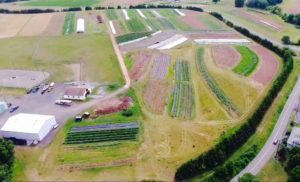
Contour Farming at Chickadee Creek Farm
GOOD NEWS though. The water running off our farm was clear. It wasn’t always like that, we had to work and change things up to protect the water. Through filter strips, contour farming, and being conscientious about when we till, we all win.
Jess Niederer is the owner of Chickadee Creek Farm, a certified organic and certified transitional organic* vegetable, flower and herb farm in Hopewell Valley, NJ. In 2016 she was named the National Outstanding Young Farmer by the Outstanding Farmers of America. Candidates are nominated from all across the country, and a panel of judges selects winners based on progress in their agricultural career, soil and water conservation, and service to their community, state, and nation.
Article and photos by Joe Mish

A juvenile myrtle warbler searches the ice shrouded shoreline of the South Branch in late February
February is midwinter’s better half, given it is two days shorter than any other month and two days closer to spring, a virtual, ‘get out of winter free, card’. The significance of those two missing days provides a powerful psychological boost to soothe winter doldrums and seasonal affective disorder accumulating since December.
Although spring is the ‘finish line’ for surviving winter, the early days of spring are often indistinguishable from winter weather. This demonstrates that our characterization of the seasons is based more on legend than reality, especially when a lingering winter feels like an eternity.
Moving from impressionable feelings and missing days to more tangible evidence, February provides many visual clues that spring is around the corner. Its 28 days are a prelude or appetizer, stirring the emotions, building anticipation for the main event, the first day of spring.
To see visual clues we need light and light is what February delivers. In 28 short days we gain about an hour of day length, most evident to causal observers by noting the later time of sunset.
The increasing day length triggers a response in people and animals as we see the start of bird migration, courtship, flowers and tree buds.
Bird migration is one of the most colorful visual cues that winter has run its course. The milder the winter the earlier migration begins. Migration may be local, as with bluebirds or two thousand of miles away for many of the colorful warblers.
Late February usually marks the very beginnings of small bird migration north. Our rivers, streams coastlines and even interstate roadways provide linear pathways for migrating birds. The most colorful and plentiful are the myriad of warbler varieties. It is not unusual to see a bright flash of color darting along the riverside in late February despite shoreline ice and cold weather. A band of north bound travelers may find temporary shelter during a cold spell on south facing hillsides or in brush along steep river banks, protected from the wind and saturated with full sun.
Hawks are usually seen now in pairs as they bond prior to nesting. The owls hooting on cold winter nights and local bald eagles may well be incubating eggs.
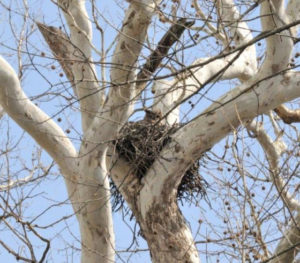
Great horned owl nesting in am old red tailed hawk nest
Muskrat, mink and fox are out and about in a courting mood. This is the time to scan fields for red fox roaming the countryside looking for mates. Love is definitely in the air.
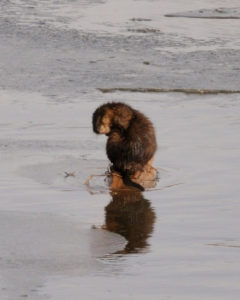
Muskrats are more often seen during their late winter early/ spring courting season
Male white-tailed deer have dropped their antlers and females are heavy with fawns as day length triggers hormonal changes to alter behavior and ensure best chances for winter survival. Now is a good time to walk the fields and woodlots to look for dropped antlers.
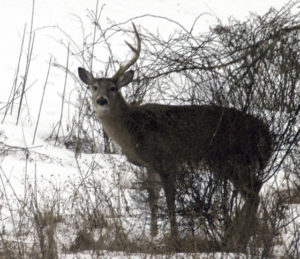
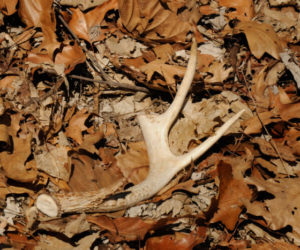
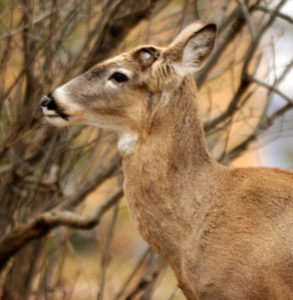
A buck has dropped one antler, the other will soon drop perhaps when it jumps a fence. A dropped antler charcterized by an irregular base. Antler buds after the antlers drop. Within a couple of months, the antlers will begin to sprout from these buds surrounded by viable tissue with a velvety appearance that readily bleeds if injured.

The first and most consistent sign of spring for me is the blooming of snowdrops, en masse on a hillside, near where I usually launch my canoe on the South Branch. As cold as it might be, the sight of those tiny white flowers gives me inspiration, fires my energy and issues a solemn promise of the return of spring.
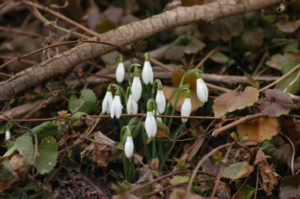
A patch of snow drops blooming midwinter heralds the return of spring
By February, the deep red leaf buds, on the trees that line the river, stand out against brown and gray interlaced branches. When viewed at a distance, the contrasting colors are enhanced as they take on a solid appearance as if created by long horizontal brush strokes in a painting.
A full moon will occur on February 11th to light up the night, as a compliment to the lengthening daylight, to make February a well lit marquee announcing next month’s arrival of spring.
Author Joe Mish has been running wild in New Jersey since childhood when he found ways to escape his mother’s watchful eyes. He continues to trek the swamps, rivers and thickets seeking to share, with the residents and visitors, all of the state’s natural beauty hidden within full view. To read more of his writing and view more of his gorgeous photographs visit Winter Bear Rising, his wordpress blog. Joe’s series “Nature on the Raritan, Hidden in Plain View” runs monthly as part of the LRWP “Voices of the Watershed” series. Writing and photos used with permission from the author.
Photos and Article by Joseph Sapia
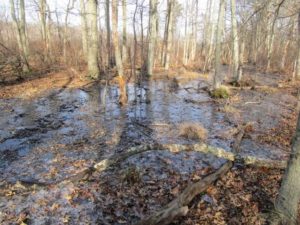
A pond at Szeliga’s Orchard
On this near-to-Christmas day, I was without my Jeep, which was in the shop for most of the day for routine, but time-consuming, maintenance. Without a vehicle, I was living life by foot – walking a mile or so to lunch at the old general store in Helmetta and picking up my mail from my third-generation Post Office box next-door. The walk was to be pragramtic, rather than playful, although I chose a route skirting the woods, instead of walking the Main Road directly from my neighborhood.
After 60 years of living and about 40 years as a journalist, I should know, Be ready for what is out there, unexpected or not. As a woodsman here in the Pine Barrens around Helmetta since old enough, I should know, A walk is not simply a walk.
So, I was glad I put my camera in my pocket.
Before I even left the neighborhood, I came upon a cluster of holly, thick with leaves and holding many berries. A Christmas treat – and my first photographs.
After about three blocks, I went afield, getting on the Pipeline, then onto the freight railroad tracks. Almost immediately on the tracks, I saw a dead mouse lying on a tie between the rails . A victim of a hawk or fox or some other cause of death? I do not know, but another photograph.
As I walked the tracks north, toward Helmetta, I noticed two species of pine: pitch, with its long, swirled needles in clusters of three, along with Virginia, with short, swirling needles in clusters of two. Their green contrasted nicely against the clear, blue sky.
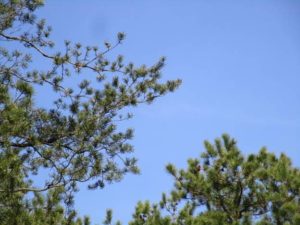
Virginia pine to the left, pitch pine to the right
After crossing Saw Mill Brook, I noticed a third pine in the old Szeliga’s Orchard: white, with supple needles in clusters of five. The species being easy to remember with its five needles, or W-H-I-T-E. It is not a native, here. This was probably an escape from nearby houses.
In the old orchard, I saw ground pine, or Lycopodium. Also, there was a nice little pond – I knew of the swamp, here, but did not remember this much ponding. And there was a fallen tree trunk, pecked by a woodpecker or woodpeckers.
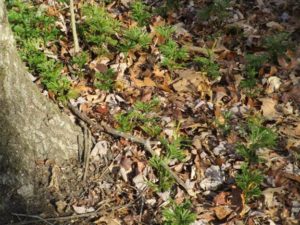
Ground pine at Szeliga’s Orchard
I got to the former worker homes of the George W. Helme Snuff Mill — which ceased production in 1993 and, this year, opened as apartments — and cut through the alley dividing them. After a visit to the Post Office and lunch at the store, I walked to Helmetta Pond.
There, I found a thin layer of ice along the shore – the temperature was now in the low 40s, but overnight it had got down to about 30. Canada geese sat in the pond on its other side by the woods. There, it was a mix of pines on the high ground, swamp hardwoods and Atlantic white cedar in the wetlands – and, it seemed, more and more invasive Phragmites reed grass.
On the way back, I took photos of ice in a ditch and Shekiro’s Pond, which had a cluster of punks, or cat-tails, dying off in the cold weather. Shekiro’s was fending off Phragmites nicely, unlike the Pond to the north and Cranberry Bog to the south.
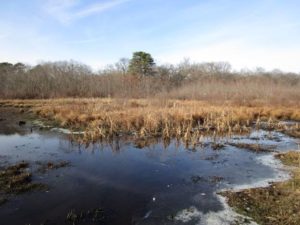
Shekiro’s Pond
At the Bog, I spooked a great blue heron, which took off slowly in flight. But not slowly enough for me to get a photograph. I did stop nearby, though, to shoot a stand of birch on the old Shekiro homestead.
On my way home, I was treated to a ConRail locomotive pulling two hopper cars toward Jamesburg. I snapped photos of the train, glad I had the camera with me over these few hours.
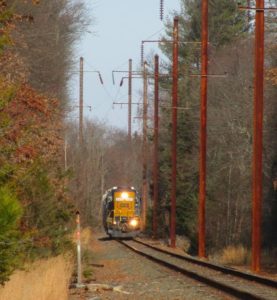
A ConRail train in Helmetta, heading toward Jamesburg
Joe Sapia, 60-years-old, grew up and lives in the Pine Barrens around Helmetta, where his family has resided for more than 100 years. He can be reached at Snufftin@aol.com or at P.O. Box 275, Helmetta, 08828.
Copyright 2016 by Joseph Sapia
Article and photos by Joe Mish
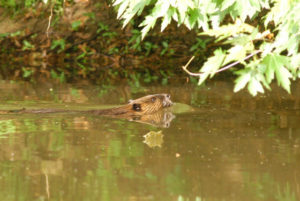
A beaver, whose existence is hidden in plain view, plies the local waters to shatter the belief the area is sanitized of wildlife typically associated with far off wilderness destinations.
As the earth turned its back to the sun on the first evening in January, the rising moon appeared as a thin silver crescent, low on the western horizon.
Just as the moon was high enough to reflect on the mirrored water of the North Branch, its perfect image was disturbed by a series of deep ripples that shattered the image into broken pieces of shimmering light.
The dark night, with minimal light reflected off the moon, made it difficult to see details, though it was clear that the disturbance was made by a beaver.
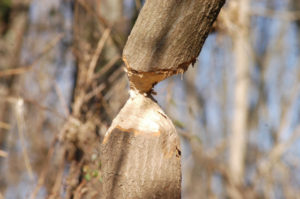
Earlier in the spring I had noticed a small tree cut down, showing unmistakable beaver sign, where a stump is gnawed evenly around, tapering to a perfect point.
For many years, beaver sign along the North and South Branch and Raritan rivers have been commonly seen in the January, February time frame. As the rivers are mostly shallow, the beaver are typically transients heading to the deeper water of the Delaware Raritan Canal or the Millstone to over winter. Many are killed by cars or trapped when they begin to fell trees across the road as was the case in Manville on the D&R canal.
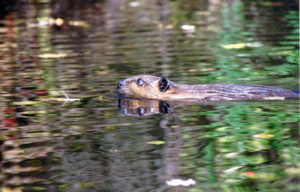
Beaver on the D&R canal built a den and felled trees across the road.
The odd thing about the freshly cut tree I saw, was that it was cut down in April. This was late in the year for a transient beaver. I kept watch all summer and saw no other sign until I noticed wide paths leading from the corn field to the river. The trail was too wide for a muskrat and too muddy for a groundhog. Apparently the beaver was feeding on corn all summer long. No sign of a den was apparent until the fall when the beaver began to cut branches and small trees, piling them at the base of exposed tree roots along a deep section of the river.
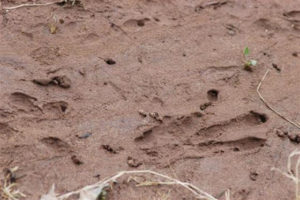
Beaver tracks in the mud along the Raritan River
It was now January, almost 3 months after the corn had been harvested and on this day the corn stubble was dusted with a light snow cover. The thin ice that formed along the banks showed a trail of bubbles made by the beaver as it traveled from its den to stockpile small branches for midwinter dining.
It was interesting to see where muskrats had been under the ice, leaving similar trails of exhaled air bubbles like the beaver, though the beaver left a trail of much larger air bubbles.
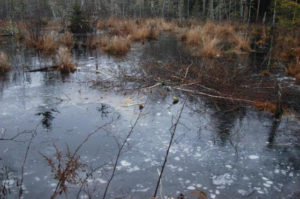
Exhale air from a beaver leaves large bubbles under the ice
Walking along the high bank and mindlessly following a set of fox tracks in the fresh snow, I saw where the beaver came ashore and went a short distance into the empty cornfield. The trail led to a vertical drop down the steep bank, which leveled off and then angled sharply to the right with a quarter turn to the left and directly into the water. It was apparent the beaver slid, rather than climbed back down into the water. A single footprint was evident where it corrected its slippery course.
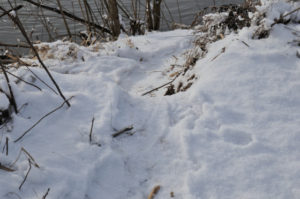
Notice the single footprint to the right side of the trail before the first drop
Further downstream across from the den there was an oak about 10 inches in diameter that the beaver had started to gnaw during the fall and abandoned in favor of several smaller trees 2 to 3 inches thick. That oak was now lying on the ground, a testament to the beaver’s determination, powerful jaws and sharp teeth. It will be interesting to see what the beaver will do with this large fallen tree.
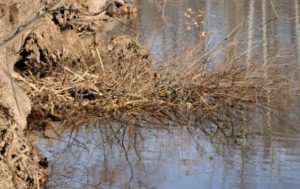
Beginnings of a beaver den or dam.
Beaver have always been associated with the wilderness, their pelts and castor glands served as motivation for French Canadian voyageurs and trappers to open the west after populations were depleted in the east.
To have beaver in our midst is a testimony to the tenacity of wildlife populations long thought erased from existence. It reminds me of Catholic school when the nuns told us to scrunch over in our seats to make room for our guardian angels. In a real sense, beaver are invisible guardian angels of our wild heritage that most people don’t believe exist and never consider.
Author Joe Mish has been running wild in New Jersey since childhood when he found ways to escape his mother’s watchful eyes. He continues to trek the swamps, rivers and thickets seeking to share, with the residents and visitors, all of the state’s natural beauty hidden within full view. To read more of his writing and view more of his gorgeous photographs visit Winter Bear Rising, his wordpress blog. Joe’s series “Nature on the Raritan, Hidden in Plain View” runs monthly as part of the LRWP “Voices of the Watershed” series. Writing and photos used with permission from the author.
Future of Menhaden Management – Public Hearing Thursday, December 8
Guest post by Zack Greenberg, Senior Associate, Environment | The Pew Charitable Trusts
Next week the Atlantic States Marine Fisheries Commission (ASMFC) is holding a hearing on the future of menhaden management. While ASMFC’s Menhaden Management Board unanimously approved the Public Information Document (PID) for Draft Amendment 3 for public comment, they need to hear from you on why it is so important to manage menhaden for their role in the marine ecosystem (Issue 1, Option D).
Tell the ASMFC that menhaden management must account for the needs of predators. The public can comment at upcoming hearings, or in writing, now through January 4, 2017. Here are the details for next week’s hearing in New Jersey:
New Jersey Division of Fish and Wildlife
December 8, 2016; 6:30 PM
Nacote Creek Marine Law Enforcement Office
360 North New York Road, Mile Marker 51
Port Republic, New Jersey
We need YOU to get involved, here’s how:
- Attend next week’s hearing on Thursday, December 8;
- Submit written comments before 5:00pm on January 4, 2017*; and,
- Share with family and friends to help get the word out!
*Public comments should be forwarded to Megan Ware, Fishery Management Plan Coordinator, 1050 N. Highland St, Suite A-N, Arlington, VA 22201; 703.842.0741 (FAX) or at comments@asmfc.org (Subject line: Menhaden PID).
The conservation of menhaden benefits everyone. Managing “the most important fish in the sea” to account for their role as forage fish will enable the population to continue to grow, while increasing menhaden’s value to recreational fishing, commercial seafood, and tourism businesses that all depend on this important fish and its predators. That is why we are supporting Issue 1, Option D.
If you haven’t seen it, here is footage of the amazing activity happening off New York and New Jersey, as we work together to protect hundreds of millions of menhaden and all that they provide to predators (including ourselves). It is hard not to get inspired when imagining what the Atlantic will look like when we restore this species to its historic abundance and range!
There are a lot of articles out there on the importance of menhaden, a few can be found by clicking below:
Remember: this is YOUR opportunity to provide input on the future management of this incredibly important forage fish – the ASMFC wants to hear from you – so make your voice heard!
Dear Friend of the Lower Raritan Watershed –
In 2016 you and your neighbors joined the LRWP for:
16 clean-ups of area streams
1 pollinator garden installation
1 rain garden installation
3 water quality monitoring trainings (visual habitat, pathogens and macroinvertebrate identification)
3 multi-week K-12 environmental education programs
9 stakeholder meetings
7 special events (dance performances, gallery openings, field trips and special lectures)
10 community meetings, environmental festivals or other outreach events
2 blessings of area streams
You also: adopted 20+ stream segments for habitat monitoring, took soil and water samples, spearheaded 30+ research/internship projects, volunteered to help shape the LRWP’s strategic and business plans, developed maps, gave presentations, created 20+ sculptures out of trash, provided counsel and advice, and so much more. For your time and commitment to a healthier Lower Raritan Watershed, we say a very sincere THANK YOU!
Now we come to you, humbly, to ask for more. We cannot advance our collective work on the path to a healthier Raritan River and Lower Raritan Watershed without your financial support. So please consider the Lower Raritan Watershed Partnership in your charitable giving.
CLICK HERE TO DONATE
We know there are many good charities that will seek your help. We are truly honored when you choose to make a tax-deductible gift to the Lower Raritan Watershed Partnership.
With all the best to you and your family for a wonderful holiday season and a happy, healthy 2017.
Heather Fenyk
President and Founder
Lower Raritan Watershed Partnership
Except as noted, article and photos by Joe Mish
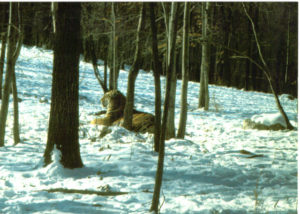
A Siberian tiger, out of place in modern times in New Jersey, comfortably rests on the frozen snow in sub zero temperatures, intensified by a strong northwest wind. Conditions that would turn exposed flesh beet red in an instant, didn’t phase this big cat as it appeared oblivious to the deadly weather; as if not bound by the laws of Nature.
It was a bitter cold day as Bert and I drove the Warner Bros Jungle Habitat trails to check on the open ranging wildlife that occupied the windswept mountains and valleys of the northern New Jersey wildlife park. Inside the warm Chevrolet truck, converted into a veterinary mobile unit, the heater was turned up high, while warm coffee steamed the windshield. Most animals escaped the polar wind hiding behind natural windbreaks and temporary shelters placed around the park.
As we drove past the tiger compound, near the highest point of the park, here was this tiger, a cat we affectionately named, ‘Bobtail’, lying down exposed to the full force of the wind. Bearing an ever present grin, for which the big cats are known, Bobtail appeared content, oblivious to the deadly arctic blast. He remained motionless and stared into the brutal wind that must have escaped from the 10th circle of Dante’s frozen hell, showing no signs of discomfort. He may as well have been enjoying a cool breeze on a warm summer’s day.
This image of Bobtail lying in the snow captures for me the essence of the tiger. Well documented accounts of tigers hunting humans in India, and their magical ability to make kill after kill and avoid inescapable traps, have elevated the tiger to supernatural status.
This is an animal believed to exist in the spirit world as a cunning killer with the ability to transform into flesh and bone and back again at will. The tiger has a reputation of defying natural law that limits all other living things; Bobtail was doing nothing to dispel that myth on this cold day.
The poem, “Tyger”, by William Blake, written in 1794, so well captures the visceral reaction I had to the tigers, I memorized the poem. Here are a few lines that chill my blood.
In what distant deeps or skies Burnt the fire of thine eyes?
And what shoulder, & what art. Could twist the sinews of thy heart?
While here is photographic proof of a tiger living in New Jersey, an anomaly for sure, it is not hard to imagine a time when big cats stalked our land. I wondered every time I passed the tiger compound, how humans ever survived these Paleolithic predators. Perhaps it was the predators’ evolved intelligence that raised the level of human creativity in a Darwinian dance played to a deadly tune.
Evidence of saber tooth cats and jaguars, among other prehistoric creatures, were found in a limestone cave in southeastern PA near Pottstown and trace back to the cretaceous period about 100 to 66 million years ago. The cave was located in a now forgotten town named Port Kennedy, which is part of Valley Forge National Park.

Evidence of sabre-tooth cats of the late cretaceous period discussed in this 1993 article. Additionally fossil remains have been found in the Cutter Clay works near Raritan Bay and along the shore across Raritan Bay in Union Beach.
NJ was unrecognizable in terms of geography and climate with glaciers terminating at the Watchung Mountains and our rivers not yet formed. The Hudson River at one time was thought to have emptied into the lower Raritan watershed at Bound Brook.
As the sea level rose and fell over the eons, it formed clay banks along the Raritan and its bay where dinosaur fossils and tracks have been found. To date, I am not aware of any prehistoric cat trackways or fossils being discovered in NJ. Though surely, when southern NJ was above water, it would be reasonable to expect prehistoric cats, whose remains were found in the Port Kennedy Cave, to have roamed our land.
In more modern times the eastern mountain lion did stalk the shores of the Raritan and in fact a bounty was offered and the last local cat killed in the Sourland Mountains in the early 19th century. Officially, the last New Jersey mountain lions were killed in the southern most counties about that same time.
Rumors of mountain lions persist in several north east states, though no hard evidence has been uncovered in NJ. Given the fact that people have been known to illegally harbor large cats in less than secure enclosures, anything is possible.
Today, New Jersey has a healthy population of bobcats, primarily in the northwest part of the state. The retreating glaciers left a boulder strewn, mountainous landscape with plenty of nooks and crannies, ideal habitat for these elusive felines. Occasionally bobcats are captured on hunters’ trail cameras to give us evidence of their presence as they are rarely ever seen even where they are plentiful.
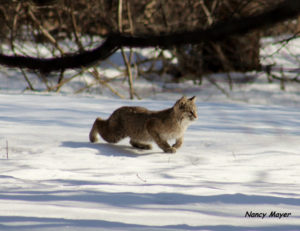
This very rare photo of a bobcat was taken in Warren County, NJ. New Jersey has a healthy bobcat population along with other wildlife thought not to exist within our borders. This cat is really a sabre-tooth tiger distilled down to miniature with all the accumulated intelligence and instincts required for survival in any geologic iteration of New Jersey. Photo by Nancy Mayer
Still the thought of saber-tooth cats, tigers and jaguars ranging across the state becomes more than just imaginary when you see the gleam in your pet cat’s eye. It is as if the prehistoric felines have been distilled down to their essence in the form of modern day cats that dominate many of our homes.
“The Man-Eaters of Kumaon”, by Col Jim Corbett, published in 1944, deals with the man eating tigers of India in the early 20th century. Please read the last chapter, “Just Tigers” before you begin the book as it puts the tiger in perspective and talks about photography vs hunting and concern for their the conservation even at that time. The first hand account of the almost supernatural ability of tigers to avoid being killed or captured while hunting humans, reveals an intellectual battle where man doesn’t always dominate nature.
THE TYGER
By William Blake
Tyger! Tyger! burning bright In the forests of the night, What immortal hand or eye Could frame thy fearful symmetry?
In what distant deeps or skies Burnt the fire of thine eyes? On what wings dare he aspire? What the hand dare sieze the fire?
And what shoulder, & what art. Could twist the sinews of thy heart? And when thy heart began to beat, What dread hand? & what dread feet?
What the hammer? what the chain? In what furnace was thy brain? What the anvil? what dread grasp Dare its deadly terrors clasp?
When the stars threw down their spears, And watered heaven with their tears, Did he smile his work to see? Did he who made the Lamb make thee?
Tyger! Tyger! burning bright In the forests of the night, What immortal hand or eye Dare frame thy fearful symmetry?
1794
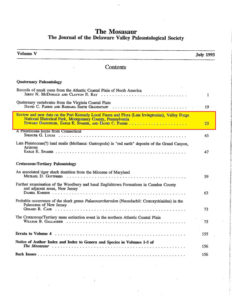
Author Joe Mish has been running wild in New Jersey since childhood when he found ways to escape his mother’s watchful eyes. He continues to trek the swamps, rivers and thickets seeking to share, with the residents and visitors, all of the state’s natural beauty hidden within full view. To read more of his writing and view more of his gorgeous photographs visit Winter Bear Rising, his wordpress blog. Joe’s series “Nature on the Raritan, Hidden in Plain View” runs monthly as part of the LRWP “Voices of the Watershed” series. Writing and photos used with permission from the author.






































